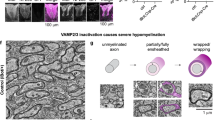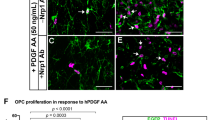Abstract
The neurotrophin receptor p75NTR is involved in the regulation of axonal elongation by neurotrophins as well as several myelin components, including Nogo, myelin-associated glycoprotein (MAG) and myelin oligodendrocyte glycoprotein (OMgp). Neurotrophins stimulate neurite outgrowth by inhibiting Rho activity, whereas myelin-derived proteins activate RhoA and thereby inhibit growth. Here we show that direct interaction of the Rho GDP dissociation inhibitor (Rho-GDI) with p75NTR initiates the activation of RhoA, and this interaction between p75NTR and Rho-GDI is strengthened by MAG or Nogo. We also found that p75NTR facilitates the release of prenylated RhoA from Rho-GDI. The peptide ligand that is associated with the fifth α helix of p75NTR inhibits the interaction between Rho-GDI and p75NTR, thus silencing the action mediated by p75NTR. This peptide has potential as a therapeutic agent against the inhibitory cues that block regeneration in the central nervous system.
This is a preview of subscription content, access via your institution
Access options
Subscribe to this journal
Receive 12 print issues and online access
$209.00 per year
only $17.42 per issue
Buy this article
- Purchase on Springer Link
- Instant access to full article PDF
Prices may be subject to local taxes which are calculated during checkout





Similar content being viewed by others
References
Dechant, G. & Barde, Y.A. The neurotrophin receptor p75(NTR): novel functions and implications for diseases of the nervous system. Nat. Neurosci. 5, 1131–1136 (2002).
Yamashita, T., Tucker, K.L. & Barde, Y.A. Neurotrophin binding to the p75 receptor modulates Rho activity and axonal outgrowth. Neuron 24, 585–593 (1999).
Davies, A.M. Neurotrophins: neurotrophic modulation of neurite growth. Curr. Biol. 10, 198–200 (2000).
Schmidt, A. & Hall, A. Guanine nucleotide exchange factors for Rho GTPases: turning on the switch. Genes Dev. 16, 1587–1609 (2002).
Yamashita, T., Higuchi, H. & Tohyama, M. The p75 receptor transduces the signal from myelin-associated glycoprotein to Rho. J. Cell Biol. 157, 565–570 (2002).
Wang, K.C., Kim, J.A., Sivasankaran, R., Segal, R. & He, Z. p75 interacts with the Nogo receptor as a co-receptor for Nogo, MAG and OMgp. Nature 420, 74–78 (2002).
Wong, S.T. et al. p75(NTR) and Nogo receptor complex mediates repulsive signaling by myelin-associated glycoprotein. Nat. Neurosci. 5, 1302–1308 (2002).
Sasaki, T. & Takai, Y. The Rho small G protein family–Rho GDI system as a temporal and spatial determinant for cytoskeletal control. Biochem. Biophys. Res. Commun. 245, 641–645 (1998).
Fournier, A.E., GrandPre, T. & Strittmatter, S.M. Identification of a receptor mediating Nogo-66 inhibition of axonal regeneration. Nature 409, 341–346 (2001).
Masuda, T. et al. Molecular cloning and characterization of yeast rho GDP dissociation inhibitor. J. Biol. Chem. 269, 19713–19718 (1994).
Feinstein, D.L. & Larhammar, D. Identification of a conserved protein motif in a group of growth factor receptors. FEBS Lett. 272, 7–11 (1990).
Koch, G., Haberman, B., Mohr, C., Just, I. & Aktories, K. Interaction of mastoparan with the low molecular mass GTP-binding proteins rho/rac. FEBS Lett. 291, 336–340 (1991).
Takahashi, K. et al. Direct interaction of the Rho GDP dissociation inhibitor with ezrin/radixin/moesin initiates the activation of the Rho small G protein. J. Biol. Chem. 272, 23371–23375 (1997).
Yaku, H., Sasaki, T. & Takai, Y. The Dbl oncogene product as a GDP/GTP exchange protein for the Rho family: its properties in comparison with those of Smg GDS. Biochem. Biophys. Res. Commun. 198, 811–817 (1994).
Ilag, L.L. et al. Selection of a peptide ligand to the p75 neurotrophin receptor death domain and determination of its binding sites by NMR. Biochem. Biophys. Res. Commun. 255, 104–109 (1999).
Schwarze, S.R., Ho, A., Vocero-Akbani, A. & Dowdy, S.F. In vivo protein transduction: delivery of a biologically active protein into the mouse. Science 285, 1569–1572 (1999).
Bentley, C.A. & Lee, K.F. p75 is important for axon growth and Schwann cell migration during development. J. Neurosci. 20, 7706–7715 (2000).
Walsh, G.S., Krol, K.M., Crutcher, K.A. & Kawaja, M.D. Enhanced neurotrophin-induced axon growth in myelinated portions of the CNS in mice lacking the p75 neurotrophin receptor. J. Neurosci. 19, 4155–4168 (1999).
Lee, K.F., Bachman, K., Landis, S. & Jaenisch, R. Dependence on p75 for innervation of some sympathetic targets. Science 263, 1447–1449 (1994).
McQuillen, P.S., DeFreitas, M.F., Zada, G. & Shatz, C.J. A novel role for p75NTR in subplate growth cone complexity and visual thalamocortical innervation. J. Neurosci. 22, 3580–3593 (2000).
Del Pozo, M.A. et al. Integrins regulate GTP-Rac localized effector interactions through dissociation of Rho-GDI. Nat. Cell Biol. 4, 232–239 (2002).
von Schack, D. et al. Complete ablation of the neurotrophin receptor p75NTR causes defects both in the nervous and the vascular system. Nat. Neurosci. 4, 977–978 (2001).
Lee, K.F. et al. Targeted mutation of the gene encoding the low affinity NGF receptor p75 leads to deficits in the peripheral sensory nervous system. Cell 69, 737–749 (1992).
Liepinsh, E., Ilag, L.L., Otting, G. & Ibanez, C.F. NMR structure of the death domain of the p75 neurotrophin receptor. EMBO J. 16, 4999–5005 (1997).
Ren, X.D., Kiosses, W.B. & Schwartz, M.A. Regulation of the small GTP-binding protein Rho by cell adhesion and the cytoskelton. EMBO J. 18, 578–585 (1999).
Forget, M.A., Desrosiers, R.R., Gingras, D. & Beliveau, R. Phosphorylation states of Cdc42 and RhoA regulate their interactions with Rho GDP dissociation inhibitor and their extraction from biological membranes. Biochem. J. 361, 243–254 (2002).
Hart, M.J., Eva, A., Evans, T., Aaronson, S.A. & Cerione, R.A. Catalysis of guanine nucleotide exchange on the CDC42Hs protein by the dbl oncogene product. Nature 354, 311–314 (1991).
Cai, D., Shen, Y., De Bellard, M., Tang, S. & Filbin, M.T. Prior exposure to neurotrophins blocks inhibition of axonal regeneration by MAG and myelin via a cAMP-dependent mechanism. Neuron 22, 89–101 (1999).
Acknowledgements
We thank Y. Takai for gifts of pGEX–GST–Rho-GDI, pEF–BOS–myc–Rho-GDI and pRSET-Dbl, R. Beliveau for yeast expressing GST-RhoA, Y. Nagai for the control TAT-fused peptide and Y. Hara for technical assistance. This work was supported by a Grant-in-Aid from the Japan Brain Foundation.
Author information
Authors and Affiliations
Corresponding author
Ethics declarations
Competing interests
The authors declare no competing financial interests.
Supplementary information
Supplementary Fig. 1.
Pep5 does not inhibit the biological effects mediated by neurotrophin binding to p75NTR. (a) Pep5 does not inhibit the NGF-induced promotion of the neurite outgrowth from the hippocampal neurons (E18 rats). NGF (50 ng/ml) was added to the cultures of dissociated hippocampal neurons with or without 100 nM TAT-Pep5. After 18 hr, cells were fixed and stained for TuJ1. Length of the longest neurite per neuron was measured. Data are mean ± s.e.m. for 30 individual neurons that have neurites longer than 30 μm. Asterisks indicate statistical significance (*P < 0.01, Student's t test). Pep5, TAT-Pep5. (b) Pep5 does not inhibit the cell death of superior cervical ganglion neurons induced by BDNF. Cultured neurons were treated with BDNF at 100 ng/ml in the presence or absence of 100 nM Tat-Pep5. After 18 hr, cells were fixed and stained with Hoechst dye to label nuclei. Apoptotic cells were counted on the basis of cellular morphology (as viewed by phase-contrast microscopy) and by the presence of condensed chromatin (detected with Hoechst dye). The results are mean ± S.E. from three experiments. Asterisks indicate statistical significance (*P < 0.01, Student's t test). Pep5, TAT-Pep5. (GIF 16 kb)
Rights and permissions
About this article
Cite this article
Yamashita, T., Tohyama, M. The p75 receptor acts as a displacement factor that releases Rho from Rho-GDI. Nat Neurosci 6, 461–467 (2003). https://doi.org/10.1038/nn1045
Received:
Accepted:
Published:
Issue Date:
DOI: https://doi.org/10.1038/nn1045
This article is cited by
-
PLK1 phosphorylates RhoGDI1 and promotes cancer cell migration and invasion
Cancer Cell International (2024)
-
RhoGDI phosphorylation by PKC promotes its interaction with death receptor p75NTR to gate axon growth and neuron survival
EMBO Reports (2024)
-
P75 neurotrophin receptor controls subventricular zone neural stem cell migration after stroke
Cell and Tissue Research (2022)
-
RhoA: a dubious molecule in cardiac pathophysiology
Journal of Biomedical Science (2021)
-
The Salmonella effector protein SopD targets Rab8 to positively and negatively modulate the inflammatory response
Nature Microbiology (2021)



